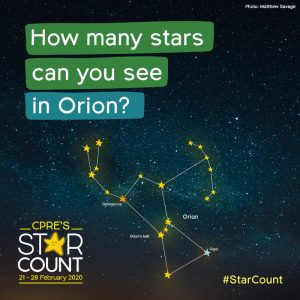How dark are our skies across Lancashire, the Liverpool City Region and Greater Manchester?
When was the last time you witnessed a really dark sky? When the familiar constellations disappeared into a speckle of light clustering more thickly around the pale band of the Milky Way? Not only is light pollution an annoyance to amateur astronomers, it can have a detrimental effect on sleep and damages the circadian rhythms of wildlife. CPRE’s annual star count, taking place between 21st and 28th February 2020, aims to map the extent of light pollution across England, and it’s easy to take part.

A star-filled sky is one of the most magical sights you can see in our countryside, and the stars have inspired art and culture for thousands of years. But too often, light pollution means that many of us can’t see the stars, especially if we live near a big town or city. Just 2% of people in England experience ‘truly dark skies’.
Light from buildings, roads and other sources can also affect wildlife, disrupt natural cycles and confuse insects and animals.
That’s why we’re counting the stars. Join in by choosing a clear night between 21-28 February and counting the number of stars you can see within the constellation of Orion. It’s easy to do, and you don’t need a telescope or any equipment.
Your results will help us create an interactive map of the nation’s view of the night sky, and where light pollution is at its worst, so local councils can take action. It’s a family-friendly activity that’s quick and easy to do, and can help more of us experience the beauty of a starry sky.
Take part: https://www.cpre.org.uk/starcount
Download a free Starry Skies activity pack, with activities, interesting facts and even a starry cookie recipe from CPRE: https://takeaction.cpre.org.uk/page/55574/data/1?ea.tracking.id=local-groups





